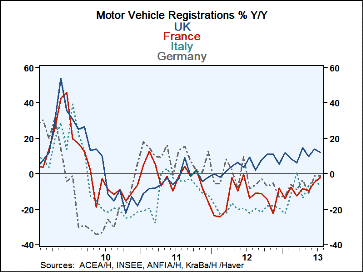 Global| Aug 16 2013
Global| Aug 16 2013Auto Sector in Europe Revives but Slowly and with Issues
Summary
Europe's auto sector is on the mend. While a number of countries are still showing erratic behavior in month-to-month sales, the German Association of the Automotive Industry (VDA) reported a strong rise in auto sales, led by the [...]
 Europe's auto sector is on the mend. While a number of countries are still showing erratic behavior in month-to-month sales, the German Association of the Automotive Industry (VDA) reported a strong rise in auto sales, led by the countries in Western Europe.
Europe's auto sector is on the mend. While a number of countries are still showing erratic behavior in month-to-month sales, the German Association of the Automotive Industry (VDA) reported a strong rise in auto sales, led by the countries in Western Europe.
In the table we've applied the VDA estimate of EU-wide sales gains, which has been reported in the press, to levels the data one year ago to create an estimate for July for EU-area sales for comparative purposes. The July percentage gain for the EU is, therefore, an estimate, but the figures for all of the countries in the tables are derived from hard data that they have reported.
The chart at the top creates the defining profile of the recovery of the European automotive sector. It shows that there has been a very steady up-creep in the pace of year-over-year sales and that the countries portrayed in the chart now show an upward thrust with values approaching zero, or surpassing zero, for year-over-year percent changes -- as is the case for the UK.
The country with the clear strong auto sector continues to be the United Kingdom. UK sales rose 1% in July. Sales/registrations are higher by 12.4% over 12 months, trailing slightly the gains that we see in Spain. Spain's year-over-year sales are up by 15.8%.
Italy continues to struggle and has the worst auto sales year-over-year. In fact, the Italian auto sector is the poster child for how not to make industry adjustment. Rather than closing factories, Italian automakers are still largely paying workers to stay home and to not work. In contrast, and of course under extreme duress, US automakers have downsized, fired workers, shuttered plants, and largely reinvented themselves to improve their standing - albeit at a smaller size and with government loans. While European auto sales are starting to gain ground (or to lose less ground, in some cases) the European auto industry remains under continuing distress.
'Recovery' of the 'auto sector' in Europe for the moment is much more story of the recovery of consumer demand, improved economic conditions, and improved economic expectations than it is a story about any revival or repair to the supply side of that still-beleaguered sector. European industry still has a long way to go, and unless it makes that journey, European demand will also fall into decay. Europe's so-far-so-good story of auto sector revival is definitely one with a huge asterisk attached and an unsure future -- despite its apparent trend of improving sales.
Robert Brusca
AuthorMore in Author Profile »Robert A. Brusca is Chief Economist of Fact and Opinion Economics, a consulting firm he founded in Manhattan. He has been an economist on Wall Street for over 25 years. He has visited central banking and large institutional clients in over 30 countries in his career as an economist. Mr. Brusca was a Divisional Research Chief at the Federal Reserve Bank of NY (Chief of the International Financial markets Division), a Fed Watcher at Irving Trust and Chief Economist at Nikko Securities International. He is widely quoted and appears in various media. Mr. Brusca holds an MA and Ph.D. in economics from Michigan State University and a BA in Economics from the University of Michigan. His research pursues his strong interests in non aligned policy economics as well as international economics. FAO Economics’ research targets investors to assist them in making better investment decisions in stocks, bonds and in a variety of international assets. The company does not manage money and has no conflicts in giving economic advice.






